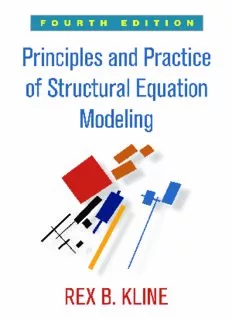Table Of Contentebook
THE GUILFORD PRESS
Principles and Practice of Structural Equation Modeling
Methodology in the Social Sciences
David A. Kenny, Founding Editor
Todd D. Little, Series Editor
www.guilford.com/MSS
This series provides applied researchers and students with analysis and research design books that
emphasize the use of methods to answer research questions. Rather than emphasizing statistical
theory, each volume in the series illustrates when a technique should (and should not) be used and
how the output from available software programs should (and should not) be interpreted. Common
pitfalls as well as areas of further development are clearly articulated.
RECENT VOLUMES
APPLIED MISSING DATA ANALYSIS
Craig K. Enders
APPLIED META-ANALYSIS FOR SOCIAL SCIENCE RESEARCH
Noel A. Card
DATA ANALYSIS WITH Mplus
Christian Geiser
INTENSIVE LONGITUDINAL METHODS: AN INTRODUCTION
TO DIARY AND ExPERIENCE SAMPLING RESEARCH
Niall Bolger and Jean-Philippe Laurenceau
DOING STATISTICAL MEDIATION AND MODERATION
Paul E. Jose
LONGITUDINAL STRUCTURAL EQUATION MODELING
Todd D. Little
INTRODUCTION TO MEDIATION, MODERATION, AND CONDITIONAL
PROCESS ANALYSIS: A REGRESSION-BASED APPROACH
Andrew F. Hayes
BAYESIAN STATISTICS FOR THE SOCIAL SCIENCES
David Kaplan
CONFIRMATORY FACTOR ANALYSIS FOR APPLIED RESEARCH, SECOND EDITION
Timothy A. Brown
PRINCIPLES AND PRACTICE OF STRUCTURAL EQUATION MODELING, FOURTH EDITION
Rex B. Kline
Principles and Practice of
Structural Equation Modeling
Fourth Edition
rex B. Kline
Series Editor’s Note by Todd D. Little
thE GuiLFord PrESS
new York London
© 2016 The Guilford Press
A Division of Guilford Publications, Inc.
370 Seventh Avenue, Suite 1200, New York, NY 10001
www.guilford.com
All rights reserved
No part of this book may be reproduced, translated, stored in a retrieval
system, or transmitted, in any form or by any means, electronic, mechanical,
photocopying, microfilming, recording, or otherwise, without written permission
from the publisher.
Printed in the United States of America
This book is printed on acid-free paper.
Last digit is print number: 9 8 7 6 5 4 3 2 1
Library of Congress Cataloging-in-Publication Data is available from the publisher
978-1-4625-2334-4 (paperback)
978-1-4625-2335-1 (hardcover)
For my family—
Joanna, Julia Anne, and Luke Christopher
and Stephen Albert Hamilton Wright (1957–2014)
I sense the world might be more dreamlike, metaphorical,
and poetic than we currently believe— but just as irrational
as sympathetic magic when looked at in a typically scientific
way. I wouldn’t be surprised if poetry— poetry in the
broadest sense, in the sense of a world filled with metaphor,
rhyme, and recurring patterns, shapes, and designs— is how
the world works. The world isn’t logical, it’s a song.
—DaviD Byrne (2009)
Series Editor’s Note
Rex Kline has assembled a fourth edition that retains all the wonderful features of his
bestselling earlier editions, and he seamlessly integrates recent advances in structural
equation modeling (SEM). Rex is a scholar of SEM and has a special gift—of being able
to communicate complex statistical concepts in language that all readers can grasp. The
accessible style of writing and the many pedagogical features of the book (e.g., chapter-
end annotated reading lists, exercises with answers) make it a “must have” for any user
of SEM. It is a resource that keeps improving and expanding with each new edition and
is the resource I recommend first on this subject—whether the question comes from a
beginner or an experienced user.
As a scholar of modern statistical practice and techniques, Rex has studied the
developments and advances in the world of SEM generally, and he has covered “hot”
topics, such as Pearl’s structural causal modeling. His coverage of Pearl’s graph theory
approach to causal reasoning, as many of the reviewers of prepublication drafts of the
fourth edition have also noted, is both easy to understand and comprehensive. It’s so
good, he ought to get a prize for best in presentation! In this new edition, he takes us
through causal mediation analysis, conditional process modeling, and confirmatory fac-
tor analysis with categorical indicators. Other additions to this masterpiece of pedagogy
include insightful discussions of significance testing, the use of bootstrap estimation,
and the principles of measurement theory.
Although Rex suggests in his Introduction that no single book can cover all of
SEM, his book is about as thorough as they come. His didactic approach is refreshing
and engaging, and the breadth and depth of material covered is simply impressive. As
he notes and you will feel, Rex is a researcher talking to you as a fellow researcher,
carefully explaining in conceptually driven terms the logic and principles that underlie
the world of SEM. The wealth of examples provide entry points for researchers across a
vii
viii Series Editor’s Note
broad array of disciplines. This book will speak to you regardless of your field or specific
area of expertise.
As always, the support materials that Rex provides are thorough: he covers now
six different SEM software packages (Amos, EQS, lavaan for R, LISREL, Mplus, and
Stata)! The Appendix material is a treasure trove of useful building blocks, from the ele-
ments of LISREL notation, to practical advice, to didactic presentation of complex ideas
and procedures. Rex has assembled real-world examples of troublesome data to demon-
strate how to handle the analysis problems that inevitably pop up. These features have
always been a mainstay of earlier editions, but they have now been expanded to cover
even more topics. Rex bookends all this material with an introductory chapter that truly
sets the stage for the journey through the land of SEM and a concluding chapter that
covers very practical best-practice advice for every step along the way.
Enjoy Rex Kline’s classic for a fourth time!
Todd d. LiTTLe
At 28,000 feet
On my way to Wit’s End
Lakeside, Montana
Description:Emphasizing concepts and rationale over mathematical minutiae, this is the most widely used, complete, and accessible structural equation modeling (SEM) text. Continuing the tradition of using real data examples from a variety of disciplines, the significantly revised fourth edition incorporates rec

